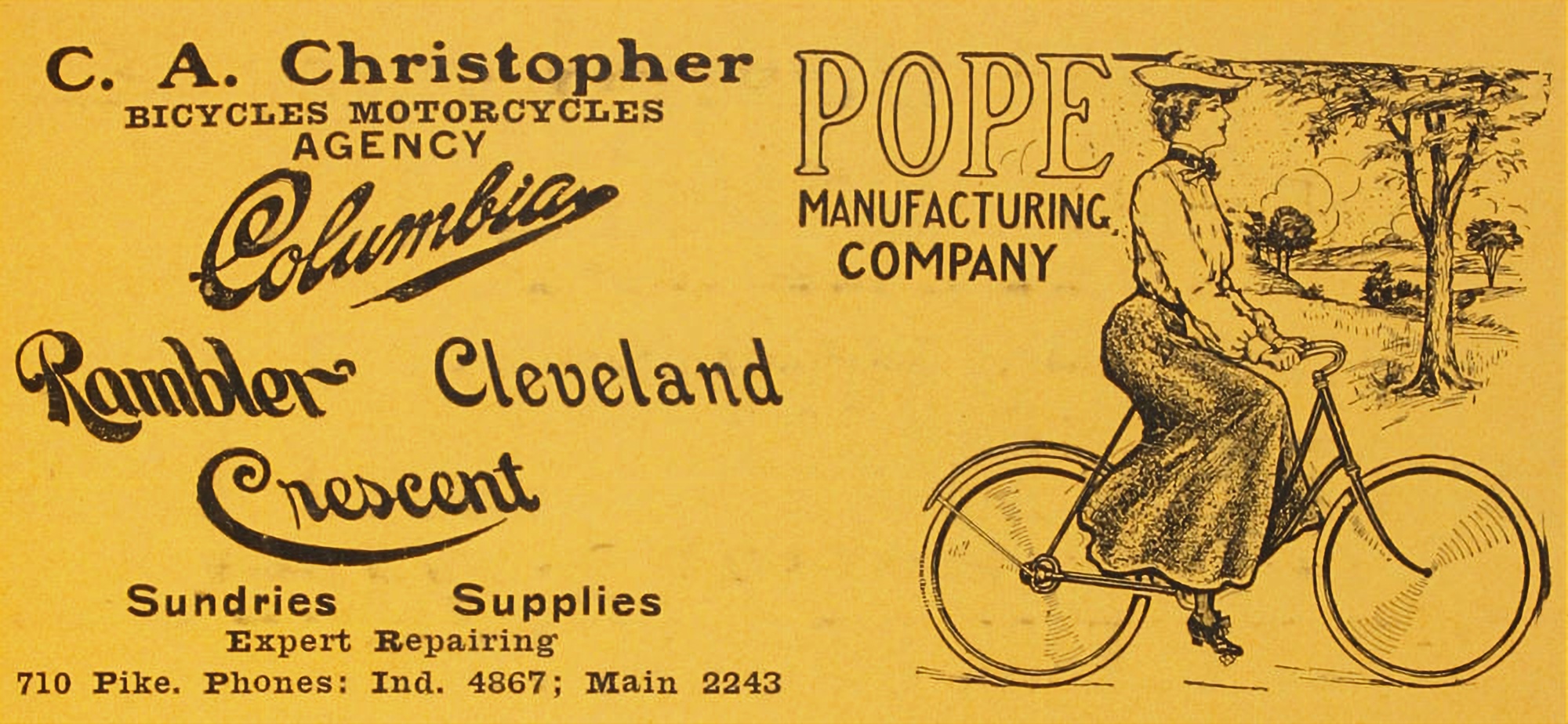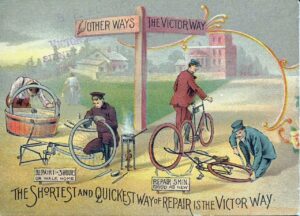A Bicycle Built for Two was a popular love song composed in 1892 – in the happier and more carefree days once known as the “Gay-(18)90s.” It was a peaceful time – before the automobile – when the bicycle beat out the horse as the best way to get around. The bicycle became part of a grassroots recreation movement, with people using leisure time to get out of the city and into the country.
In the 1880s, High-wheel bicycles were new and popular. Even though they were heavy, made of iron and wood, and dangerously hard to ride. The first popular models were known to be dangerous because of the frequency of “headers” or flying over the handlebars. However, with the invention of “Safety” and several other modifications, the bicycle became safer and more popular.
The women’s safety, allowing for women’s dress, helped boost the popularity of the bicycle even more. By the 1890s, the safety bicycle could be used by everyone, regardless of age or gender, for both transportation and recreation.
The Capital Bicycle Club (C.Bi.C.) was founded on January 31, 1879 by Frank G. Wood, Max Hansmann, Fred D. Owen. L.P. Einolf, Herbert S. Owen, Louis N. Jesunofsky, and (the younger) Charles Krauskopf.
now know how the bicycle emancipated women, but it wasn’t exactly a smooth ride. The following list of 41 don’ts for female cyclists was published in 1895 in the newspaper New York World by an author of unknown gender. Equal parts amusing and appalling, the list is the best (or worst, depending on you look at it) thing since the Victorian map of woman’s heart.

A bicycle relay race between Washington, D.C., and Pittsburgh began in the former of those two cities. This major event was organized and sponsored by the Pittsburgh Leader newspaper.
Wheeling Against Time, September 2, 1892
The stated purpose of the race was to have dozens of bicyclists take turns carrying a message from U.S. Army Brigadier General Albert Ordway in Washington, D.C., to the Pittsburgh Leader’s office in the Steel City in 24 hours or less. “Wheeling Against Time” was the headline the Washington-based Evening Star featured to describe the race.
As commander of the National Guard of the District of Columbia (NGDC), Ordway strongly supported bicycles and their potential uses. However, the ambitious race between Washington and Pittsburgh was about more than just his interest in bicycles or any need for him to have a message hand-delivered to a faraway newspaper. The race was also seen as a reflection of the ever-growing nationwide enthusiasm for bicycles and an opportunity to showcase the potential challenges experienced by those using this means of transportation.
The Washington Post reported, “The race is looked upon in wheeling circles as a greater event than the late relay race between Chicago and New York, for though the distance – 300 miles [482.8 kilometers] – is shorter, the country to be traversed is much worse, including nine ranges of mountains, several of which will have to be crossed at night.”
The riders in the relay carry a message written by President Benjamin Harrison, and it is expected that the ride will be completed by noon tomorrow. Frederick Futterer will carry the letter from Middletown to Boonsboro, accompanied by two others, from Boonsboro to Hagerstown. Charles Johnson will deliver the letter.
The news broke in local newspapers.
THE RELAY RACE.
“One, Two, Three, Go!” — Now They are Off — Watch ‘Em.
The great relay bicycle race against time, from Washington, D.C., to Pittsburg, Pa., is in progress today, and wheelmen in all this section of the country are excited over the event’s outcome.
The distance to be covered is about 400 miles, and the race is run to determine the efficiency of a bicycle service in time of war, should it ever happen that communication by rail, telegraph, or horseback was rendered impossible. The race is under the auspices of the Pittsburg Leader, and Mr. T.S. Fullwood, of that paper, have been over the route arranging the details.
Messrs. Le Roy Hayes and Burton C. Shildkneck of Hagerstown, who are to ride the relay from Frederick to Middletown, arrived here last night and are at the City Hotel today. The riders of the first relay left Washington at 2 o’clock this afternoon and will reach Frederick at 6.15 this evening by way of Ridgeville and New Market. A detachment of the 2nd Separate Company Washington Military Cyclers arrived here this morning and will send a relay to New Market this afternoon to relieve the relay at that point and ride into Frederick. Messrs. Hayes and Shildneck will leave immediately upon the arrival of the New Market relay and expect to reach Middletown in 45 minutes. A relay will then ride to Boonsboro in 50 minutes, one from Boonsboro to Hagerstown in 40 minutes, and at Hagerstown, a relay of Cumberland men will ride to Cumberland; from there, the ride to Pittsburg being made by Pittsburg century riders.
Would today’s ‘wheelmen’ do as well as the old?
The following outstanding video was produced by the National Museum of American History.
The next two videos come from our friends in England.
There is also an interesting book called Wheels of Change: How Women Rode The Bicycle to Freedom (With A Few Flat Tires Along The Way) by Sue Macy.
Published by National Geographic Society, Ms. Macy tells the fascinating U.S. story:
“It’s hard to grasp the full extent of the bicycle’s impact on Americans in the late 19th century – particularly female Americans. Imagine a population imprisoned by their very clothing; the stiff corsets, heavy skirts, and voluminous petticoats made it difficult to take a deep breath, let alone exercise. Additionally, the laws and social conventions cemented a man’s place as head of the household and holder of the purse strings. How suffocated women must have felt. And how liberated they must have been as they pedaled their wheels toward new horizons.
“Wheels of Change looks at how the bicycle took America by storm in the 1880s and ‘90s, especially how it changed women’s lives. It also explores the bicycle culture of the era with short features appearing after each chapter that highlight the impact of the two-wheeler on everyday life.
“Bicycling by young women has helped to swell the ranks of reckless girls who finally drift into a standing army of outcast women of the United States. The bicycle is the devil’s advance agent morally and physically in thousands of instances.”
*Much more in our next installment of Bicycle Craze.

Related Links and Sources
For more information on the the Bicycle Craze, check out these links:
https://networks.h-net.org/tags/harry-platt